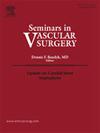老年人慢性静脉、动脉和糖尿病性伤口的评估和处理
IF 2.4
3区 医学
Q1 PERIPHERAL VASCULAR DISEASE
引用次数: 0
摘要
无法愈合的伤口越来越普遍,占全球人口的1%至2%,其中老年患者的发病率更高。由于阻碍愈合的生理变化、促进炎症和损害微循环的常见医学合并症、营养状况和活动能力差以及接受护理的心理社会障碍,这些慢性伤口对老年成人患者构成了挑战。在这篇文献综述,流行病学,病理生理学,系统成本和管理慢性静脉下肢溃疡,动脉溃疡和糖尿病足创伤的老年患者进行了调查。不断发展的皮肤结构,促炎细胞的变化和感染的倾向使老年人群处于所有伤口类型的危险之中。本文概述了通过体格检查、标准化工具和患者特异性特征来区分未愈合伤口的策略。针对每种类型的伤口,提出了最佳伤口护理管理原则,包括伤口床清创、水分优化、生物膜控制和水肿管理。继发于静脉功能不全的下肢静脉溃疡在老年人中特别常见,并且经常复发,需要创新的加压技术和组织替代品。新兴疗法,包括皮肤移植,高压氧和局部氧,和床边成像设备,讨论。最后,老年患者容易受到社会环境的影响,使他们面临伤口护理不佳和愈合不良的风险。在老年创伤患者中,必须承认并解决获得常规护理人员、行动不便、伤害性疼痛和神经性疼痛以及身体虚弱等问题。本文献综述的目的是澄清这些因素,巩固意识,并提倡多学科方法的伤口护理管理。本文章由计算机程序翻译,如有差异,请以英文原文为准。
Assessment and management of chronic venous, arterial, and diabetic wounds in older adults
Nonhealing wounds are increasingly prevalent, present in 1% to 2% of the global population, with higher incidence in geriatric patients. These chronic wounds pose challenges to older adult patients owing to physiologic changes that hinder healing, common medical comorbidities that promote inflammation and damage microcirculation, poor nutritional status and mobility, and psychosocial barriers to receiving care. In this literature review, the epidemiology, pathophysiology, systems costs, and management of chronic venous leg ulcers, arterial ulcers, and diabetic foot wounds in older adult patients are investigated. Evolving skin structure, pro-inflammatory cellular changes, and propensity for infection place the geriatric population at risk for all wound types. Strategies to differentiate between nonhealing wounds through physical examination, standardized tools, and patient-specific characteristics are outlined. Optimal wound care management principles for each wound type, including wound bed debridement, moisture optimization, biofilm control, and management of edema are addressed. Venous leg ulcers secondary to venous insufficiency are particularly common in older adults and often recur, requiring innovative techniques in compression and tissue substitutes. Emerging therapies, including skin grafts, hyperbaric and topical oxygen, and bedside imaging devices, are discussed. Finally, older adult patients are susceptible to social circumstances that place them at risk for suboptimal wound care and poor healing. The combination of access gaps to regular caretakers, immobility, nociceptive and neuropathic pain, and frailty must be acknowledged and addressed in older adult patients with wounds. The aims of this literature review were to clarify these factors to consolidate awareness and to advocate for a multidisciplinary approach to wound care management.
求助全文
通过发布文献求助,成功后即可免费获取论文全文。
去求助
来源期刊
CiteScore
3.50
自引率
4.00%
发文量
54
审稿时长
50 days
期刊介绍:
Each issue of Seminars in Vascular Surgery examines the latest thinking on a particular clinical problem and features new diagnostic and operative techniques. The journal allows practitioners to expand their capabilities and to keep pace with the most rapidly evolving areas of surgery.

 求助内容:
求助内容: 应助结果提醒方式:
应助结果提醒方式:


